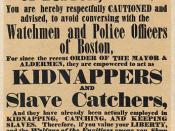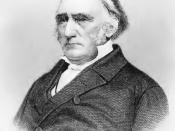Huckleberry Finn illustrates the thought and acceptance of slavery in the late nineteenth century (at the rise of revolts by angry slaves). At first the story seems like any other. Huck, a young thirteen year old Caucasian male is just trying to make an imprint on life and be freed from all the ÃÂcivilized people.ÃÂ He, in time embarks on a death-defying journey down the fearful Mississippi River on board a wooden raft. However underneath its cover the book shows how America and slavery tried, but could not coexist.
Although born and raised in Missouri Mark Twain aggressively opposed slavery. When he was a young boy Twain witnessed the beatings and cruelty towards slaves and publically criticized about the abolition of slavery. In 1885 he sent a letter to Francis Wayland, Dean of Yale University Law School, which was published in the New York Times, Twain demanded compensation for former slaves and said "We have ground the manhood out of them, and the shame is ours, not theirs, and we should pay for it."
These are some of the words that Mark Twain wrote to Francis Wayland on December 24, 1885. Mark was a powerful influence on the African American movements and was one of their strongest advocates.
Huck Finn was published twenty years after the civil war ended ÃÂ a war mainly fought over the dilemma of slavery. This was a huge problem because the narrative showed racism and intolerance toward colored people. Several main characters throughout the novel characterized typical slave owners who were racist and represented the worst of what society had to offer (As shown by the Phelps family when Jim is put into a shed). Twain reveals his bad side as a satirist through the innocence of HuckÃÂs narrative (since he is a child and does not fully understand things about the world); Twain attacks slavery, racism, hypocrisy, and discrimination towards American history to show how horrible it was. This gives strong evidence that Twain opposed slavery.
One of the main plotlines and most cold-hearted greed shown in the book is when a slave family is separated. Con artists, the Duke and the King, masquerade as heirs to the dead Peter Wilks and take charge of his property (H.F. pg. 153). Just two days after PeterÃÂs funeral, theDuke and the King send PeterÃÂs family of slaves to opposite ends of the river (H.F. 169). The mother went to New Orleans while her two boys went to Memphis. They were sold separately, which was typical in the slave trade to gain more of a profit. Whenever a slave escaped, slave laws ordered that the slave be returned to his/her master. Sally and Silas Phelps, Tom Sawyer's aunt and uncle, believe they are upholding their "civic dutyÃÂ when they lock up Jim on their farm until his rightful owner can be found (H.F. pg. 243). This is another example of cruel and nasty behavior towards African-Americans. Twain reveals how horribly slaves were treated on large plantations through the small-mindedness of Mary Jane Wilks, the daughter of the dead George Wilks. Amazingly, she believes that her slaves are happy and treated kindly when the slaves disagree. They get treated healthier than most slaves in the south but Mary doesnÃÂt realize the true feelings of her slaves. If this was the well treated slaves then just imagine the badly treated ones! If Mary Jane demonstrates the ÃÂbestÃÂ of slave owners then it is hard to imagine the worst ones. They must have been whipped and forced to pick crop from sunrise to sunset!Even in his own way, Tom Sawyer treats blacks with disrespect. An example of this is when Tom knows that Jim (formally Miss WatsonÃÂs slave) is set free but does not confront Huck about it. He does this so Huck and him can plan a way to free Jim (ÃÂItÃÂs just like in the booksÃÂ Tom would say). In the planned escape the three of them almost get killed along Tom getting shot.
Mark Twain also very accurately points out major laws of the late 1700ÃÂs and mid 1850ÃÂs. First, there was the Fugitive Slave Act of 1793 that authorized the arrest and capture of slaves escaping north as told by Pap when Huck and he are in his cabin (H.F. pg. 91). This law was barely enforced and typically ignored by northerners. As conflict to slavery built up and to force northerners to put up with with slavery laws, southerners proposed and approved the Fugitive Slave Act of 1850. This new law authorized the return of runaway slaves regardless of where in the U.S. they may be located at the time of their arrest. This is what happens when Jim escapes from Miss Watson (HuckÃÂs step aunt). Readers might wonder why Huck and Jim head downriver instead of going directly to Illinois (which was a free state at the time). It seems logical that once Jim gets into northern territory, he becomes a free man. However, it was not that simple, because he would have to keep avoiding the ÃÂbounty huntersÃÂ out for the prize money for the capture of runaway slaves. In an act of betrayal, the Duke and the King sell Jim to the Phelps for money when theirs runs out. This just goes to show how much the fugitive slave laws were enforced; even the cons couldnÃÂt risk keeping Jim.
The novel ends with a happy picture when Miss Watson sets Jim free before she dies (H.F. pg. 265). However, itÃÂs most likely that Jim's freedom didnÃÂt last long. In 1857, the Dred Scott Decision supported the Fugitive Slave Act of 1850. The law was passed by the United States Supreme Court and stated that slaves were personal property and could never be free. It seem as though Jim suffered the same fate as all other blacks in the U.S.
Bibliography - Huckleberry Finn Book By: Mark Twain





